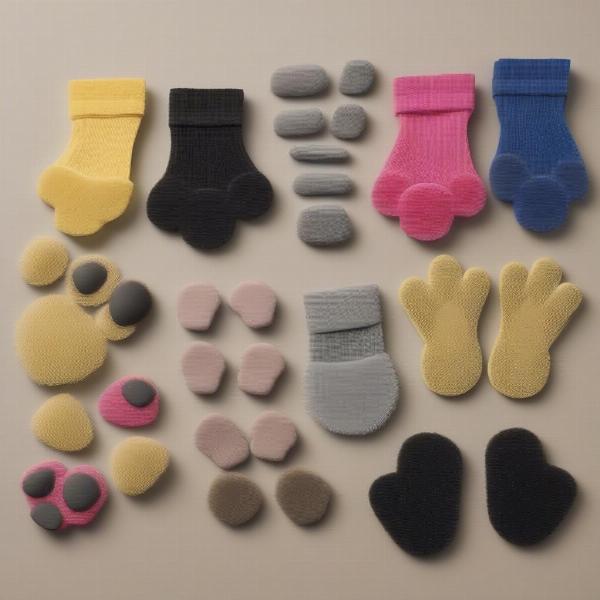Paw grips for dogs are becoming increasingly popular among pet owners looking to improve their furry friends’ safety and mobility, especially on slippery surfaces. These handy accessories can help prevent slips and falls, offering peace of mind for both the dog and the owner. Whether your dog is a senior struggling with arthritis, a young pup exploring new terrains, or simply prone to slipping on hardwood floors, paw grips can offer a simple yet effective solution.
Why Consider Paw Grips for Your Dog?
Many factors can contribute to a dog’s instability on smooth surfaces. Age-related decline in muscle strength and coordination, joint conditions like arthritis, and even just the natural slipperiness of certain flooring materials can make it difficult for dogs to maintain their footing. This can lead to painful falls, injuries, and a decreased quality of life. Paw grips offer extra traction, allowing dogs to move with more confidence and reduce the risk of accidents.
Preventing Slips and Falls
One of the primary benefits of paw grips is their ability to prevent slips and falls. The added grip provided by the textured material allows dogs to maintain a secure footing, even on slippery surfaces like tile, hardwood, and laminate flooring. This is especially crucial for senior dogs, who are more susceptible to injuries from falls. paw grips for senior dogs can help them navigate their homes safely and maintain their independence.
Types of Paw Grips
Several types of paw grips are available, each with its own advantages and disadvantages. Some popular options include:
- Socks with rubberized soles: These offer excellent grip and can also provide warmth in colder climates.
- Rubberized booties: These are durable and waterproof, ideal for outdoor use.
- Adhesive paw pads: These are disposable and easy to apply, offering a temporary solution for specific situations.
Choosing the right type of paw grip depends on your dog’s individual needs and lifestyle.  Various types of dog paw grips displayed
Various types of dog paw grips displayed
Finding the Right Fit for Your Dog
Ensuring a proper fit is crucial for both comfort and effectiveness. A paw grip that is too loose can easily slip off, while one that is too tight can restrict circulation and cause discomfort. Always measure your dog’s paws carefully before purchasing paw grips and consult the manufacturer’s sizing chart.
Introducing Paw Grips to Your Dog
Getting your dog accustomed to wearing paw grips requires patience and positive reinforcement. Start by letting your dog sniff and investigate the paw grips. Then, gradually introduce them to wearing the grips for short periods, rewarding them with treats and praise. dog paw traction can be significantly improved with consistent and positive training.
Maintaining Paw Grips
Most paw grips are easy to clean and maintain. Simply wipe them down with a damp cloth or follow the manufacturer’s instructions for specific cleaning recommendations. Regularly check the paw grips for wear and tear and replace them as needed.
Conclusion
Paw grips can be a valuable tool for improving a dog’s safety and mobility. By providing extra traction on slippery surfaces, they can help prevent falls and injuries, allowing dogs to move with confidence and maintain their independence. Choosing the right type of paw grip and ensuring a proper fit is crucial for maximizing their effectiveness. sticky pads for dogs feet offer a simple and effective way to enhance your dog’s safety and well-being.
FAQ
-
Do all dogs need paw grips? Not all dogs require paw grips, but they can be particularly beneficial for senior dogs, dogs with mobility issues, and those living in homes with slippery flooring.
-
How can I get my dog used to wearing paw grips? Introduce the paw grips gradually with positive reinforcement, using treats and praise.
-
How often should I replace my dog’s paw grips? Replace them as needed when they show signs of wear and tear.
-
Can paw grips be used outdoors? Some paw grips are designed for outdoor use, offering protection and traction on various terrains.
-
Are paw grips expensive? The cost of paw grips varies depending on the type and brand, but they are generally an affordable solution for improving a dog’s safety.
-
What if my dog chews on their paw grips? Monitor your dog while they are wearing paw grips, and if they show signs of chewing, consider alternative solutions or consult with a veterinarian.
-
Can paw grips help with arthritis? While paw grips don’t treat arthritis, they can provide added stability and support, which can be beneficial for dogs with joint pain.
Related Articles
About ILM Dog
ILM Dog is your trusted international resource for all things canine. We offer expert advice on dog breeds, health, training, nutrition, grooming, and much more. Whether you’re a seasoned dog owner or just starting your journey, ILM Dog provides practical and reliable information to help you provide the best possible care for your furry companion. Contact us for more information: Email: [email protected], Phone: +44 20-3965-8624.